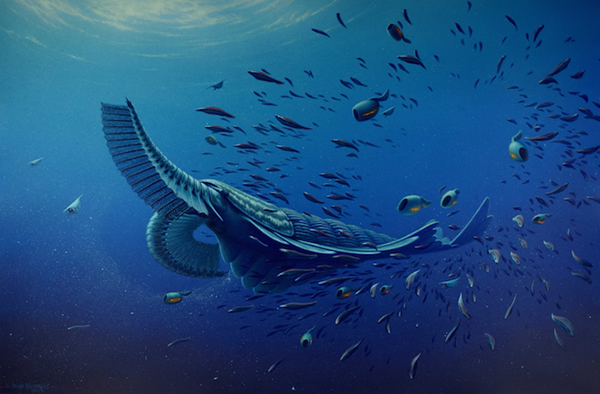Enormous Shrimp Was Gentle Giant of Cambrian Seas
This is an artist's depiction of the giant shrimp that roamed Cambrian seas 485–540 million years ago.
A top predator approximately 540 million years ago was an over two-foot-long shrimp relative that was the first known actively swimming filter feeder, according to the latest issue of Nature.
It was perhaps the most peaceful time on the planet, since the shrimp-like animal, Tamisiocaris borealis, had no predators and did not have to chase and attack prey.
“It is unlikely that there was anything that hunted Tamisiocaris,” lead author Jakob Vinther told Discovery News. “It was among the largest animals of its time. Therefore, it could calmly swim around and eat like a gentle giant without feeling the slightest hint of a threat, just like modern whale sharks (do today).”
New fossils of the creature, collected from early Cambrian (485–540 million years ago) sediments in northern Greenland, provide a detailed look at its anatomy. T. borealis was an anomalocaridid. These were marine animals that later gave rise to arthropods, a group that includes shrimps, other crustaceans, spiders and insects.
Previously, it was thought that the huge shrimp-like animal grabbed prey and shoved victims into its relatively big mouth. Analysis of the new fossils negates that scenario.
“They used the fine mesh of bristles on their feeding appendages for trapping small planktonic crustaceans, similar to water fleas or sea monkeys,” Vinther, a lecturer in macroevolution at Bristol University, explained.
“By sweeping the net-like or comb-like appendages through the water, almost like a butterfly fancier would do on a meadow, it gathered the teeming schools of little crustaceans and moved them up to its mouth where they would get sucked in.”
Before this research, scientists didn’t think oceans were teeming with life during the early Cambrian. Fossil evidence suggested that a lot of animal activity was happening on sea floors, but that the water column itself was sparsely populated. T. borealis and some other recent finds change that theory.
Filter feeding itself would not be possible if the water wasn’t full of little organisms to eat.
Vinther said that evidence has also been found for water fleas, planktonic algae (which the fleas ate), small predators such as arrow worms, trilobites, comb jellies and other mid-sized species.
Taken together, he said the evidence strongly suggests that the Cambrian marine ecosystem “must have been highly productive, with a high density of production at the bottom of the food chain. This (filter feeding) strategy only evolves if there are high densities of food particles in the water, otherwise the main way to be that big is to eat things that are slightly less big with cunning stealth.”
Modern whales and whale sharks -- both filter feeders -- migrate between areas with high productivity, such as waters off the California coast and Antarctica. Baleen whales evolved when a highly-productive ecosystem first emerged around the Antarctic.
Greg Edgecombe, a researcher in the Earth Sciences Department at the National History Museum in London, told Discovery News that, until this new study, T. borealis had been known from just one specimen.
“The new specimens clear up the mystery of what this animal was,” Edgecombe said, adding that the conclusion that it was a filter feeder expands the range of feeding strategies known to have existed among the early shrimp relatives.
Derek Briggs, who is director of the Yale Peabody Museum of Natural History, told Discovery News, “Vinther and colleagues' paper provides the first clear evidence of a large anomalocaridid that fed on tiny planktonic animals rather than preying on larger forms.”
Briggs continued, “The existence of such large suspension feeders in the Cambrian was previously unknown. This discovery represents an important advance in our understanding of Cambrian ecosystems.”(Mar 26, 2014 02:00 PM ET // by Jennifer Viegas)












